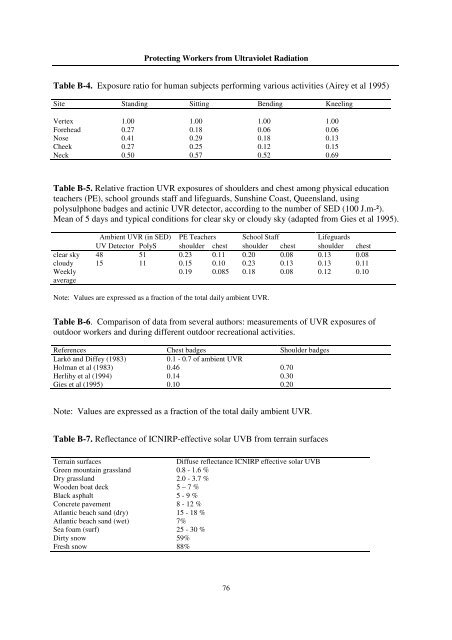Protecting Workers from Ultraviolet Radiation - icnirp
Protecting Workers from Ultraviolet Radiation - icnirp
Protecting Workers from Ultraviolet Radiation - icnirp
You also want an ePaper? Increase the reach of your titles
YUMPU automatically turns print PDFs into web optimized ePapers that Google loves.
<strong>Protecting</strong> <strong>Workers</strong> <strong>from</strong> <strong>Ultraviolet</strong> <strong>Radiation</strong><br />
Table B-4. Exposure ratio for human subjects performing various activities (Airey et al 1995)<br />
Site Standing Sitting Bending Kneeling<br />
Vertex 1.00 1.00 1.00 1.00<br />
Forehead 0.27 0.18 0.06 0.06<br />
Nose 0.41 0.29 0.18 0.13<br />
Cheek 0.27 0.25 0.12 0.15<br />
Neck 0.50 0.57 0.52 0.69<br />
Table B-5. Relative fraction UVR exposures of shoulders and chest among physical education<br />
teachers (PE), school grounds staff and lifeguards, Sunshine Coast, Queensland, using<br />
polysulphone badges and actinic UVR detector, according to the number of SED (100 J.m-²).<br />
Mean of 5 days and typical conditions for clear sky or cloudy sky (adapted <strong>from</strong> Gies et al 1995).<br />
Ambient UVR (in SED) PE Teachers School Staff Lifeguards<br />
UV Detector PolyS shoulder chest shoulder chest shoulder chest<br />
clear sky 48 51 0.23 0.11 0.20 0.08 0.13 0.08<br />
cloudy 15 11 0.15 0.10 0.23 0.13 0.13 0.11<br />
Weekly<br />
average<br />
0.19 0.085 0.18 0.08 0.12 0.10<br />
Note: Values are expressed as a fraction of the total daily ambient UVR.<br />
Table B-6. Comparison of data <strong>from</strong> several authors: measurements of UVR exposures of<br />
outdoor workers and during different outdoor recreational activities.<br />
References Chest badges Shoulder badges<br />
Larkö and Diffey (1983) 0.1 - 0.7 of ambient UVR<br />
Holman et al (1983) 0.46 0.70<br />
Herlihy et al (1994) 0.14 0.30<br />
Gies et al (1995) 0.10 0.20<br />
Note: Values are expressed as a fraction of the total daily ambient UVR.<br />
Table B-7. Reflectance of ICNIRP-effective solar UVB <strong>from</strong> terrain surfaces<br />
Terrain surfaces Diffuse reflectance ICNIRP effective solar UVB<br />
Green mountain grassland 0.8 - 1.6 %<br />
Dry grassland 2.0 - 3.7 %<br />
Wooden boat deck 5 – 7 %<br />
Black asphalt 5 - 9 %<br />
Concrete pavement 8 - 12 %<br />
Atlantic beach sand (dry) 15 - 18 %<br />
Atlantic beach sand (wet) 7%<br />
Sea foam (surf) 25 - 30 %<br />
Dirty snow 59%<br />
Fresh snow 88%<br />
76



